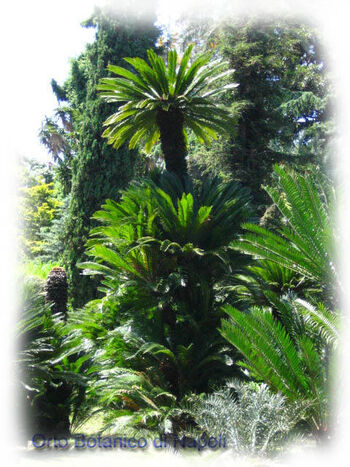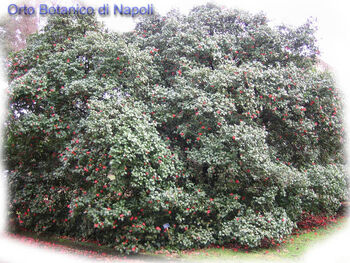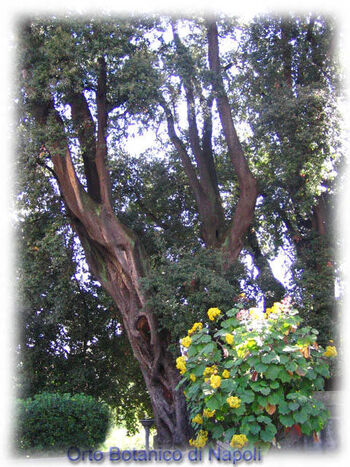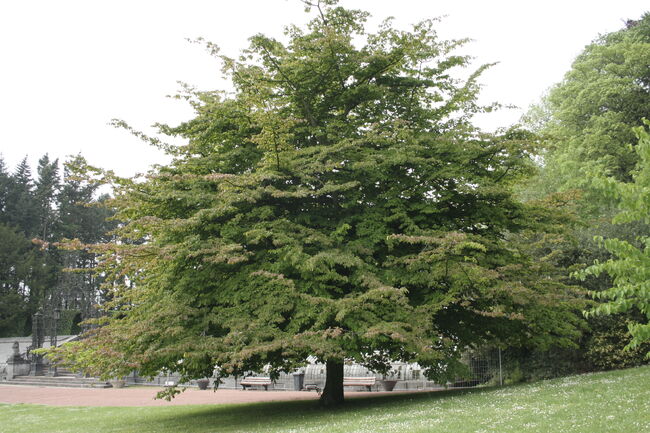Via Foria 223, 80139 Napoli - Italia - Tel.: +39 081 2533937 - e-mail: robnap@unina.it
|
|
|
|
מבט מקרוב |
מבט מעל |
הגן הבוטני של נאפולי,(Orto Botanico di Napoli, גם Real Orto Botanico ) הוא מתקן מחקר מאוניברסיטת נאפולי פדריקו השני .
שטחו של הגן משתרע על פני 15 דונם. המתקן הוא חלק מהמחלקה של האוניברסיטה למדעי טבע . זהו אחד המתקנים המדעיים וחינוכיים הרבים הנהיגו תחת שלטון הצרפתי בנאפולי ( 1806-1815 ) . הגן נפתח ב1810.
בשלב נוכחי מציגה הגינה בשטח כ -25,000 דגימות של צמחייה , המשתרעות על כ -10,000 מיני צמחים . למרות שפתוח לקהל רחב ,הגן הוא לא גן ציבורי במובן צר . זה מתקן חינוכי לאוניברסיטה ובתי ספר התיכוניים מקומייםו נפרד מהמחלקה החקלאית של האוניברסיטה של נאפולי. הגן הוא גם מעורב באופן פעיל בשימור של מיני צמחים בסכנת הכחדה. יש גם סעיף Ethnobotany של הגן שבו צמחים הם למדו שהם עשויים להיות שימושיים , לרפואה , לבני אדם. חוץ ממבנים קטנים יותר בשטח, יש שני אלה גדולים יותר :" הטירה, " 17th משוחזר מהמאה לאחרונה,והחממה מרולה 5,000 מ"ר. הטירה מכילה חדרי הרצאות ותצוגה,ובתי המוזיאון לחקר המאובנים של הצמחיםוEthnobotany
צמחי הגן הנבחרים[]
Cycas revoluta A[]

בגן מצוי דגם של הצמח, באזור Pinophyta, אשר ניתרם בשנת 1813 על-ידי Maria Carolina Bonaparte רעייתו של ז'ואקים מיראGioacchino Murat - שהיה מלך נאפולי ומלך שתי הסיציליות. מירא היה מבכירי חייליו של נפוליאון בונפרטה. הוא שישא לאחותו הצעירה, קרולינה בונפרטה
ציקס המופשל (דקל סאגו, סאגו המלך, ציקס סאגו, דקל סאגו יפני), הוא מין של חשופי זרע ממשפחת ציקסאים (Cycadaceae), יליד דרום יפן. זהו אחד מכמה מינים המשמשים לייצור של סאגו למאכל, כמו גם כצמח נוי.
מבין ציקסים הוא הפופולרי ביותר בטיפוח. הוא נמצא כמעט בכל הגנים בוטניים, במקומות שניהם ממוזגים וטרופיים. באזורים רבים של העולם, הוא קידם במידה רבה באופן מסחרי כצמח נוף. זה גם די פופולרי כמו צמח בונסאי (ננסי).
הריבוי של ציקס המופשל מתבצע על ידי זרעים או על ידי יחורים שהוסרו מהגזע. זהו אחד ציקסים המתורבתים ביותר. הוא גדל בחוץ באזורים ממוזגים וסובטרופיים חמים, או בחממות באזורים קרים יותר. הוא גדל טוב ביותר באדמת חולית, מנוקזת היטב, רצוי עם חומר אורגני. הוא זקוק לניקוז טוב או שהוא יירקב. יכול לסבול בצורת מתונה, גדל גם בשמש מלאה או צל חיצוני, אבל צריך אור בהיר כאשר גדל בתוך הבית.
סאגו ציקס הוא מאוד רעיל לבעלי חיים (כולל בני אדם). חיות מחמד נמצאים בסיכון מוגבר, הסימפטומים של ההרעלה מופיעים כ-12 שעות אחרי הבליעה והם עשויים לכלול הקאות, שלשולים , חולשה, התקפים, ואי ספיקת כבד או רעילות כבדיה מאופיינת בצהבת, כל חלקי הצמח רעילים ; עם זאת, הזרעים מכילים את הרמה הגבוהה ביותר של הרעל Cycasin הגורם לגירוי במערכת העיכול, ובמינונים גבוהים מספיק יוביל לאי ספיקת כבד.
ראו את הערך המלא:Cycas revoluta
Parrotia persica B[]

מהגן הבוטאני של נאפולי
Parrotia persica (עץ ברזל הפרסי) הוא עץ נשיר ממשפחת Hamamelidaceae ונמנה על סדרת סדרת הבקעצוראים. הוא מן יחידי בין Parrotia אך קרוב ל:witch-hazel genus Hamamelis. מולדתו היא צפון אירן והוא אנדמי (כלומר רק שם טבעו לגדול) בהרי אלברוז.
גובהו של העץ מגיע עד ל-30 מטר ורוחבו 8-15 מטר. קוטר הגזע הוא עד 150 ס"מ. קליפת הגזע היא חלקה, בעלת צבע ורדרד-חום ומתקלפת. דומה לקינמון, נוטים לצבעים: ורוד, ירוק ,וצהוב חיוור באופן דומה לעצי דולב. העלים מסורגים, דמויים ביצה , לעתים קרובות נוטה צדה במקצת ,גודל העלה: 6-15 סנטימטר ארוך ו:4-10 סנטימטר (רוחב , עם שוליים גליים ; הם ירוקים מבריקים , ובסתיו הופכים לסגולים-אדומים.
הפרחים הם קצת דומים לפרחי מכשפות אגוז אבל אדום כהים ; הם מיוצרים גם בסוף החורף בעירום נובע, אך נבדלים בכך שעליי גביע מעוגל רק ארבעה ללא עלי כותרת ; אבקנים עם זאת די בולטים , ויצרומ"מ האשכול אדום 3-4 צפוף על פני. הפרי הואקפסולה שני שביל המכילה שני זרעים, אחדבכל מחצית.
Parrotia persica טופח כצמח נוי. הצבע שלו מדהים בסתיו והקליפה הדקה נותנים לו את העדיפות בגן.
בגני הנוי מקובלים הזנים הבאים: :
- 'Horizontalis': semi-weeping, wide-spreading horizontal branching pattern.
- 'Pendula' (Kew Form): Compact, weeping, quite graceful
- 'Select': Young leaves have purple margins, otherwise same as species
- 'Vanessa': Upright, columnar habit
ראו ערך מורחב בויקיפדיה האנגלית:Parrotia persica
C Melaleuca styphelioides[]

Melaleuca styphelioides, di origine australiana, è rappresentata nell’arboreto da uno dei primi esemplari di questa specie introdotti in Italia. Tale entità è caratterizzata da una corteccia dalla consistenza cartacea, cosicché al tatto il tronco si presenta leggermente soffice.
מהויקיפדיה האנגלית
Melaleuca styphelioides, known as the Prickly-leaved paperbark or Prickly Paperbark, is a plant native to eastern Australia.
It is a small to medium sized tree up to 20 metres high with a dense, rounded canopy and drooping branchlets.[1][2] The spongy bark is white or light brown and peels of in large strips.[2]
The sessile leaves are 7 to 15 mm long and 2.5 to 6 mm wide.[1] These are slightly twisted, have sharply-pointed tips, and are arranged alternately on the branchlets.[2]
Flowers appear in summer in cream or white cylindrical "bottlebrush" spikes which are 2 to 5 cm long and 1 to 2 cm in diameter. Often new growth appears at the end of the spikes.[2] Following flowering, grey-brown, woody capsules appear in clusters along the branchlets. These are ovoid, stalkless and 3 to 4 mm in diameter [2]
Distribution and habitat
The species occurs along stream banks or other moist situations, mostly in coastal areas from Nowra in New South Wales and northwards in to Queensland.[1]
Cultivation
The species thrives in a variety of situations ranging from swampy to hot and dry, and due to its deep-rooting characteristics lawn can be grown under its canopy.[3] It is used as a street tree in Sydney, with good examples in Campsie, an inner southwestern suburb, and also along numerous streets in various suburbs of Greater Melbourne.[4]
D Zelkova carpinifolia Dippel[]

L’esemplare della specie caucasica Zelkova_carpinifolia presente nell’arboreto ha una circonferenza alla base di circa 5 m.
מיני עצים נשירים זה, נפוצים בטבע באזור הקווקז, יכולים להגיע לגובה של 25-30 מ 'וקוטר גזע גדול מ -2 מ'.העלווה, אשר בסתיו מניחה צבע כתום יפה, היא פחות או יותר כדורי ועשויות מהעלים עד 10 סנטימטר צורה ארוכה, ovate-סגלגלה עם שוליים משוננים.הפרחים מיניים, לא בולט וצבע ירקרק וצהוב;הפירות הם אגוזים קטנים בקוטר של 5-6 מ"מ.
היה בשימוש הקווקז הזלוקיה וכמה מינים קשורים, במיוחד בעבר, כגון צמחי נוי, כפי שמעידים על ידי הנוכחות של דגימות בגודל ניכר בכמה פארקים. בגן הבוטני של נאפולי היא דגימת הגוף אליה מסומן בבסיס על ידי מעגל של 5 מ '.
Questa specie arborea caducifoglia, diffusa allo stato spontaneo nella regione caucasica, può raggiungere un’altezza di 25–30 m ed un diametro del tronco superiore a 2 m. La chioma, che in autunno assume una bella colorazione aranciata, è più o meno globosa ed è composta da foglie lunghe fino a 10 cm, di forma ovato-ellittica e con margine dentato. I fiori sono unisessuali, poco appariscenti e di colore giallo-verdastro; i frutti sono piccole noci dal diametro di 5-6 mm.
La zelkova del Caucaso ed alcune specie affini sono state utilizzate, soprattutto in passato, come piante ornamentali, com’è testimoniato dalla presenza di esemplari di notevoli dimensioni in alcuni parchi. Nell’Orto Botanico di Napoli è presente un esemplare il cui tronco è caratterizzato alla base da una circonferenza di 5 m.
מאתר הגן
ראו ערך מורחב:Zelkova carpinifolia Dippel
מהויקיפדיה האנגלית
Zelkova carpinifolia (Zelkova or Caucasian Zelkova) is a species of Zelkova, native to the Caucasus, Kaçkar, and Alborz mountains in the extreme southeast of Europe and southwest Asia.
It is a medium-sized to large deciduous tree growing to 20-35 m tall, with a trunk of up to 2 m in diameter. The crown is a highly distinctive vase-shape, with a short broad trunk dividing low down into numerous nearly erect branches. The leaves are alternate, 4-10 cm long and 2.5-6 cm broad, the margin bluntly serrated with 7-12 teeth on each side. The flowers are inconspicuous and greenish, with no petals, and are wind-pollinated. The fruit is a small nutlet 5-6 mm in diameter.
It is grown as an ornamental tree in Europe (huge exemplars of it can be found quite often in western part of Georgia called Imereti, used for decorating courtyards in villages and making a pleasant shadow) and more rarely in North America (where the related Japanese Z. serrata is more popular).
- Hybrid cultivars
- Zelkova × verschaffeltii
Seed suppliers
- B and T World Seeds, Paguignan, 34210 Aigues-Vives, France [1]
- Lawyer Nursery, Montana Highway, 6625 West Plains, MT., USA [2]
- Sandeman Seeds, 7 Route de Burosse, 64350 Lalongue, France [3]
- Sheffield's Seeds Co. Inc. [4], New York, USA.
E Camellia japonica[]

L’esemplare di Camellia japonica localizzato di fronte all’ingresso del Castello è uno dei più vecchi tra quelli presenti nel continente europeo
Camellia japonica (the Japanese camellia) is one of the best known species of the genus Camellia. Sometimes called the Rose of winter, it belongs to the Theaceae family. It is the official state flower of Alabama.
In the wild, it is found in mainland China (Shandong, east Zhejiang), Taiwan, southern Korea and southern Japan.
Camellia japonica is a flowering tree or shrub, usually . Some cultivated varieties achieve a size of 72m² or more. The youngest branches are purplish-brown, becoming grayish-brown as they age. The alternate leathery leaves are dark green on the top side, paler on the underside, usually The base of the leaf is pointed (cuneate), the margins are very finely toothed (serrulate) and the tip somewhat pointed.
In the wild, flowering is between January and March. The flowers appear along the branches, particularly towards the ends, and have very short stems. They occur either alone or in pairs, and are
ראו ערך מורחב:Camelia_japonica
F Gardenia thunbergia[]
Un grosso esemplare di Gardenia thunbergia, specie originaria dell’Africa meridionale, è presente nel cortile del Castello.
ראו ערך מורחב:Gardenia thunbergia
G Quercus ilex[]

I lecci (Quercus ilex) localizzati nei pressi della Serra Monumentale erano con ogni probabilità già presenti prima della fondazione dell’Orto Botanico; infatti, nella “Veduta della Serra Monumentale”, incisione in rame degli inizi del XIX secolo attribuita a Giacinto Gigante, gli esemplari in questione appaiono già di rilevanti dimensioni.
מהויקיפדיה האנגלית
Quercus ilex, the evergreen oak, holm oak or holly oak is a large evergreen oak native to the Mediterranean region. It takes its name from holm, an ancient name for holly. It is a member of the List of Quercus species#Section Quercus|white oak section (botany) of the genus, with acorns that mature in a single summer. It was first introduced to the United Kingdom in the 16th century. The first trees to be planted from acorns into England are still to be found growing within the stately grounds of Mamhead Park, Devon. They are uncommonly fine examples; several of these trees are 3 m (10 ft) in circumference at 1 m (3 ft) from the ground, and one of them measures 4 m (13 ft 6 in) in circumference. One specimen in Milo, Italy, in Sicily is reputed to be 700 years old while a small population on the slopes of northern village of Wardija in Malta are said to be between 500 and 1,000 years old. Quercus ilex is the national tree of Malta and prior to the Carthaginian period was prevalent on the islands.
מהויקיפדיה האנגלית[]
The Botanical Garden of Naples, Italy (in Italian: Orto botanico di Napoli, also Real Orto Botanico) is a research facility of the University of Naples Federico II.
The premises take up about 15 hectares and are located on via Foria, adjacent to the gigantic old Albergo dei Poveri, the Royal Hospice for the Poor under the Bourbon dynasty. The facility is part of the university’s Department of Natural Science. It is one of the many scientific and educational facilities instituted under French rule in Naples (1806–15). The Garden opened in 1810.
At present the Garden displays on the premises around 25,000 samples of vegetation, covering about 10,000 plant species. Although open to the public, the Garden is not, strictly speaking, a public park. It is really an educational facility for the university and local high schools and is separate from the agricultural department of the University of Naples. The Garden is also actively engaged in the preservation of endangered plant species. There is also an ethnobotany section of the Garden where plants are studied that are potentially useful, medicinally, to humans. Besides smaller structures on the premises, there are two larger ones: the 17th-century "castle," recently restored, and the 5,000 square meter Merola Greenhouse. The castle contains lecture and display rooms, and houses the Museum of Paleobotany and Ethnobotany
הערו שוליים[]
- ↑ 1.0 1.1 1.2 "Melaleuca styphelioides". PlantNET - New South Wales Flora Online. Royal Botanic Gardens & Domain Trust, Sydney Australia. http://plantnet.rbgsyd.nsw.gov.au/cgi-bin/NSWfl.pl?page=nswfl&lvl=sp&name=Melaleuca~styphelioides. Retrieved 2009-11-03.
- ↑ 2.0 2.1 2.2 2.3 2.4 שגיאת תסריט: היחידה "citation/CS1" אינה קיימת.
- ↑ שגיאת תסריט: היחידה "citation/CS1" אינה קיימת.
- ↑ שגיאת תסריט: היחידה "Citation/CS1" אינה קיימת.





